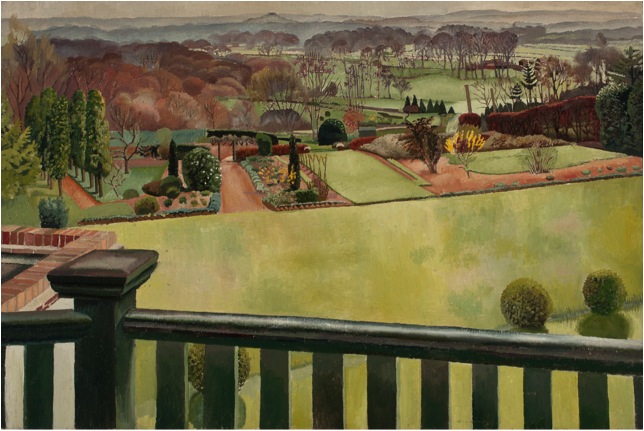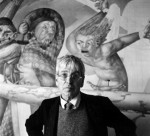
Stanley Spencer
British, 1891-1959
Oxfordshire Landscape, 1939
oil on panel
27 × 36 3/4 × 3 1/4 in.
SBMA, Gift of Mary and Will Richeson Jr.
1973.88.2

Photograph of Stanley Spencer standing before one of his religious paintings.
"When I lived in Cookham I was disturbed by a feeling of everything being meaningless. But quite suddenly I became aware that everything was full of special meaning and this made everything holy... I observed this sacred quality in most unexpected quarters."
-Stanley Spencer
RESEARCH PAPER
"Sex" and "religion" may not be the first two words that come to your mind when contemplating an English landscape, yet they are themes that are important to understanding the work of Stanley Spencer, a painter whose "Oxfordshire Landscape" is in SBMA's Permanent Collection.
The challenge of considering Spencer as an artist alongside this particular work, done in oil paint on panel, is that Spencer is best known for his figurative compositions. We have a landscape. Spencer's figurative work could be highly fanciful. Our landscape appears to be a precise rendering of an actual place. He shocked much of his public with his frankly observed nudes and with his improbable constructions of people in all varieties of embrace. We have pretty trees and flowers. But did you see the show on PBS where the art historian and nun, Sister Wendy, remarked on an artist's depiction of fluffy pubic hair? Well that was Stanley Spencer, and you will find that he has brought the same love of God's creation, the same powers of minute observation and painstaking, unsentimentalized depiction, to our English landscape.
HIS LIFE
Stanley Spencer was born in 1891 in the small English town of Cookham, 30 miles west of London along the River Thames. Cookham was surrounded by water meadows that would sometimes cut it off from the rest of the world. Spencer was to create a personal philosophy and a body of work that was similarly isolated from outside influence.
From his cozy country childhood in a religious household, two influences endured. One was a love of enveloping domesticity that would show up in his paintings of comfy, overstuffed people surrounded by the soothing detritus of everyday life. The other was a sturdy, unadorned sort of spirituality that would inspire Biblical tableaus placed in modern Cookham settings - Jesus, for example, carrying his cross down a cottage-lined street, or enduring crucifixion in a nearby quarry.
In 1925, Spencer married a fellow art school student named Hilda Carline. The introduction of a physical relationship into Spencer's life mingled with his religious beliefs in an interesting way. He became convinced that sexual passion was a means to religious ecstasy. So it was, perhaps, with an sense of entitlement that Spencer later pursued an infatuation with another Cookham artist named Patricia Preece. He divorced Hilda and married Patricia, insufficiently discouraged by the fact that she was a lesbian living with another woman. Patricia refused to live with Stanley as his wife, then sold the home she'd made him deed over to her, saying she needed the money. Historians have attributed Patricia's interest in Stanley to financial greed and a desire to succeed as an artist under the advantage of his by-then considerable reputation. An evaluation of his motives has been undertaken by Pamela Gems in her Tony-award-winning play, Stanley.
The ending of this real-life drama was bittersweet. Hilda and Stanley remained friends through a series of her nervous breakdowns. They wrote each other voluminous letters which they read aloud to each other, almost daily, until her eventual death from breast cancer. And Stanley eventually got his house back. Lord Astor bought it for him in 1959, the same year Stanley was knighted by Queen Elizabeth, the same year he died.
HIS CAREER
Stanley's extraordinary talent was recognized from the time he enrolled in Slade School, London's most prestigious art school at the time. That was 1908. He won two important awards and the admiration of a professor who wrote to Spencer's parents that their son showed signs of having the most original mind of any student in memory. He exhibited in Roger Fry's ground breaking "Second Post Impressionist Exhibition" in 1912, and a self portrait done in 1914 sold well and brought him a great deal of recognition.
By the 1930s, the Patricia Preece years, his paintings had taken on a sort of whirling, chaotic quality. Compositions showed masses of people in all sorts of communion - with each other, with plants, even pets. These paintings expressed Spencer's deep conviction that passion and desire were at the center of God's creativity, and they were decidedly different from any other art being produced. Reactions varied. A one-man show mounted in 1936 caused him to be hailed as a genius who had reinvented British painting, liberating it from European modernism in general and Picasso in particular. But just the year before, The Royal Academy, of which Spencer had become an Associate, refused to hang two of his paintings, likely because they were considered too strange or too sexually explicit.
Eventually, Spencer's figure paintings grew so peculiar and unlovely that he had a hard time selling them. It was the landscapes that kept him in business. At one point Spencer told his dealer that no one could buy a landscape unless they bought one of his "God" paintings too. After the end of the Second World War, Spencer was taken seriously as an artist again, but more as an oddity than as an important influence or example. Still, he was able to end his life as a revered member of the British art establishment.
ARTISTIC INFLUENCES
The Slade School, when Spencer attended, had a rigorous emphasis on drawing over painting. This is likely why Spencer developed the practice of beginning all his figure paintings with a meticulous draftsmanship that he called his "knitting." Also while at Slade School, Spencer became fascinated with the Old Masters - Massacio, Giotto, Donatello, Fra Angelico, Botticelli, and others. His figure drawings exhibited a similar scale and directness of vision. When, later in his life, someone asked Spencer what he thought of Picasso, he answered, "I don't know. I've not got beyond Piero della Francesca.
That's not entirely true. Spencer's work has been compared to the 16th century artist Pieter Bruegel who was also famous for compositions dense with everyday-sorts of people. Both men were deeply connected to the idea of a "village," and both were far more concerned with a painting's subject matter than with pursuing a specific style. More contemporary still was the Pre-Raphaelite Dante Gabriel Rossetti, who Spencer admired, and Paul Gauguin whose vibrant colors affected Spencer's palette.
THE PAINTING
The palette in Oxfordshire Landscape is, however, nothing like Gauguin's. The muted mauves and grays, soothing shades of green, and accents of rusty browns form a selected palette, but a very realistic one - the very shades that the subdued lighting of an overcast day selects from nature's typical profusion. The serene colors are matched by a tranquil composition of mostly horizontal lines. From the first, most voluminous shape, that of a balcony's railing that stretches horizontally across the entire immediate foreground, we are led back and back into a succession of horizontal planes that have arranged nature for our exploration.
So much about this painting invites to enter and experience, viscerally, the moist air, the pungent smells of grass and earth. The balcony itself makes us, as viewers, part of the painting's foreground. But Spencer has also given us a point of view that is higher up than what we would experience if we were actually standing at the balcony's edge, placing us as if we are ready to soar into the unfolding vista.
We see first the expanse of yellow green lawn which takes up nearly half the canvas and, by its flat simplicity, heightens the detail beyond, From the lawn we are drawn further into the painting by all sorts of paths - one wide, grassy promenade near the center, and many other earthen walks - that reach through the formality of ordered trees, hedges and shrubs to the less cultivated countryside. And beyond that, just before the blurred stretches of distant hills, there is something that takes a while to notice - a diffuse light, perhaps fog borne, nestled in the furthest trees, creating a subtle sense of destination.
Just as the Old Masters Spencer so admired drew admirers into their painting with mathematical perspective, Spencer had drawn us into his with an atmospheric perspective that flattens volume, blurs shapes and diminishes colors as the space recedes. The technique makes this canvas so much more inviting than if everything we saw was equally distinct. By giving us the solidity of the balcony to start with and the wide lawn to ground us, Spencer has given us, emotionally, a stable start for our contemplative journey, and compositionally, a spare contrast to the complexity beyond.
Notice how Spencer has all but eliminated sky, and think, for a moment, how an expanse of that grayish blue would have diminished this dense fecundity. The same artist who put Jesus on the streets of 20th century Cookham has placed God before us, not in the vaulted heavens, but in the earthbound blades of grass and silvered leaves. If God is in the details, than he is surely here where plants are rendered so distinctly as to be almost identifiable by their Latin names.
Spencer was said to be so fond of nature, so able to see God's presence in its various forms, that he would sometimes go outside and throw himself, writhing, onto a lawn. It would be easy, I suppose, to overlook that type of emotional content in this particular work, when we've come to see the replay of detail as a passionless exercise. But Spencer said the only really passionate love affairs he'd had had been with places rather than human beings. The spiritual integration he sought was not just with people but with nature, and he said that a person is a place's fulfillment just as a place is a person's. Art, said Spencer, was the visual translation of epiphany. And good art, he said, was just saying "ta" to God.
BIBLIOGRAPHY
MacCarthy, Fiona. Stanley Spencer: An English Vision . Yale University Press, 1997.
Schama, Simon, "The Church of Me," The New Yorker , Vol. LXXIII, No. 1, February 17, 1997, pp. 50-61.
Tate Gallery Liverpool, "Stanley Spencer: A Sort of Heaven," March 25, 1992 -
January 7, 1993.
Newton, Eric. The Penguin Modern Painter: Stanley Spencer . Harmondsworth, Middlesex, England: Penguin Books Ltd., 1947.
Anthony d'Offay Gallery, London, "Stanley & Hilda Spencer."
Benfey, Christopher, "A Poet of Sexual Gloom: Stanley Spencer at the Hirshhorn,"
Slate, (an Internet publication), October 22, 1998.
Price, Aimee Brown, "Stanley Spencer: Under and English Heaven," Art in America , September 1998, pp. 78-138.
Prepared for the SBMA Docent Council by Lisa Robertson, 1999.
SBMA CURATORIAL LABELS
Sir Stanley Spencer, although regarded as a wayward eccentric for much of his life, and thus outside the mainstream of of artistic developments, is now rightly regarded as one of the outstanding figures in the history of twentieth-century British art. He was one of the group of talented students at the Slade along with Adrian Allinson, David Bomberg and Mark Gertler later referred to by Professor Tonks as “an outbreak of talent.” His major achievement was the decoration of the Oratory Chapel of All Souls at Burghclere, with murals inspired by Giotto’s Arena Chapel at Padua, which occupied him from 1927-31. The scenes depicted in these murals are all based on his wartime experiences and throughout his life his great spiritual works were set in and around the Thames-side village of Cookham where he was born, which he viewed with a pre-Raphaelite intensity.
- British Modernism Whistler to WWII, 2016
